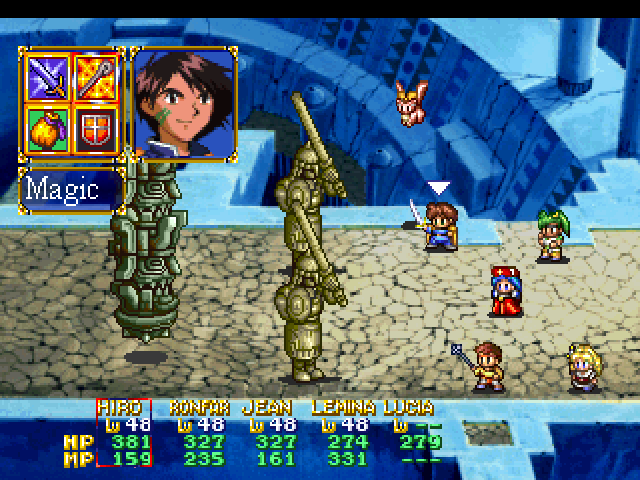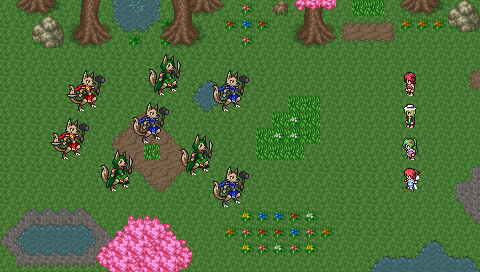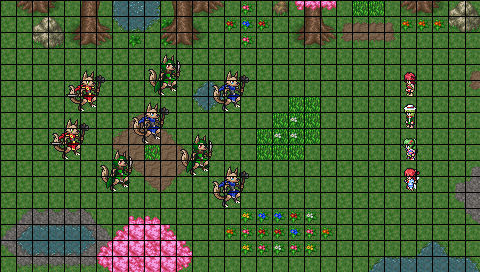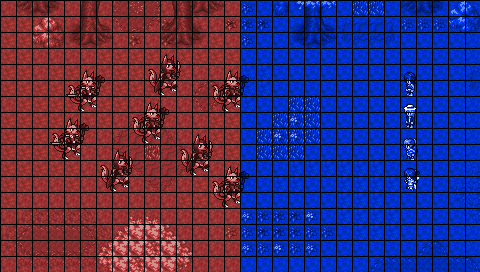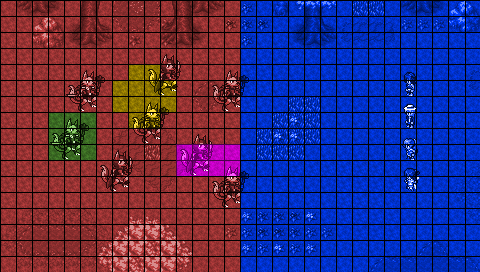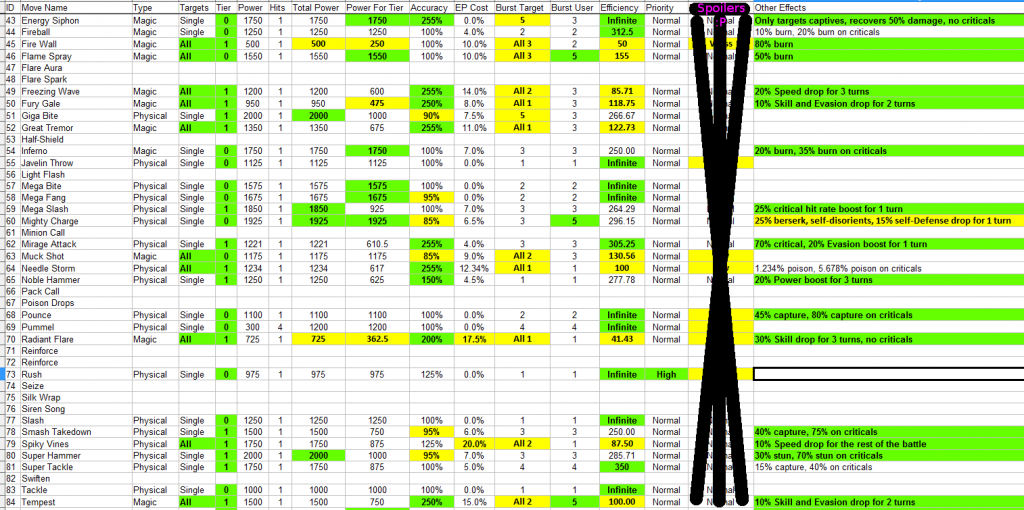It’s a little tough for me to think super clearly right now; I just might have pushed myself a bit too hard last week—Thanksgiving time here in the US and also making some more preparations for my trip later in December— since I seem to have either come down with some kind of sickness for the first time in several years or the fatigue has finally caught up with me.
Fortunately I did have some time to write about what I intend to do with grids, so let’s talk about it anyway!
Grid-based battles in RPGs are typically handled in one of two ways. Probably the most common of these is the Fire Emblem style, also seen in other games like Tactics Ogre:
In this style of battle, all the blue characters are in your control and all the red characters are enemies. You can move your characters in any order one at a time and they move within a certain number of square spaces, e.g. the one riding a horse can move farther than the ones on foot. When you’re within range to battle an enemy, heal an ally, etc., you can do that. After you’ve moved everybody, then the computer takes its turn (or “phase”) and also moves its characters in any order one at a time to battle yours.
This is probably more straightforward than I’m making it sound! If you’re on your computer or for some other reason won’t mind streaming video from YouTube, then you could start here around 2:19:49 to get a feel for it:
Fire Emblem is one of my favorite game series, but everything about the design comes with its pros and cons.
Moving each character one at a time is mentally engaging because of the needed strategy to readjust your plan after every one or two moves depending on how battles play out, but it can also feel somewhat tedious physically later in the game when you’ll be moving twelve or more characters in each phase.
During your turns, almost everything goes according to plan and even in cases when you’re rolling dice (e.g. you have a 65% chance to hit the enemy), you’re told upfront what those odds are and you don’t get blindsided by anything, so it has a strong feeling of fairness; on the other hand, since you don’t get blindsided by anything during the moments when you’re in control, the game can feel a little less dynamic compared to other RPGs where your attacks might be interrupted by enemies and you have to adapt.
The system of switching between your phase and the enemy phase is simple in theory and gives you maximum control over coordinating your characters’ movements and attacks, but it also comes at the expense of making sense from an in-universe standpoint. For example, a horse-riding enemy who might theoretically want to run away from your mage, who’s running on foot, can’t get away just because it’s not the rider’s phase, not because of something in the game world that would explain how this happens. Another example is that you can move your character with 3 Speed before your character with 20 Speed.
The bottom line is that there’s a reason this type of grid-based system is reserved for strategy RPGs, emphasis on the “strategy.” Just by the nature of each “player” taking their entire turn at a time, there’s not as much back-and-forth between you and the enemies, but instead you’re switching roles frequently between being the active player and the passive observer.
The second most common way to use a grid in RPGs is the Final Fantasy Tactics style:
Yikes, have those graphics ever aged ungracefully. :P
Anyway, in this setup, characters on both your side and the enemy side act one at a time according to their Speed stats. So it could be that one of your characters moves first, then an enemy, then two of yours in a row, then four enemies in a row, then three of yours, etc.
To a certain degree this makes more sense from an in-universe standpoint than the Fire Emblem style, but it still makes a lot less sense than the traditional Final Fantasy style (like, say, FF through FFX). This is because of the component of movement. Why does the character with 7 Speed get to move 5 entire spaces before the character with 6 Speed gets to move 5 entire spaces? It would be incredibly tedious if they traded off moving only one space at a time until finally the character with 7 Speed gets one extra space at the end, so we know why the developers didn’t design it that way, but that doesn’t explain how it works in the game universe.
In games like the traditional Final Fantasy series or Chrono Trigger, characters act according to their Speed stats, but with no movement in the game to muddy the waters. Of course the character with 7 Speed gets to cast one magic spell before the character with 6 Speed, but that’s all it is… one action. Makes sense. It’s the old spaghetti Western trope of whoever draws the fastest. (Things do get complicated when characters get to take multiple actions per turn later in a game, but more on that perhaps another day. :P)
An upside to the FFT style of system is that there’s more of a give and take. Your plans are always being interrupted or thwarted by enemies getting in your way, which can feel a little more authentic, and you aren’t simply setting up your goals and then moving toward them with no obstacles.
…but a downside is that it can also be a bit overbearing. In a Fire Emblem or Tactics Ogre style of game, at least when it’s your turn it’s really your turn because you get to move all of your characters with full control. In FFT, when it’s your turn, it’s only that individual character’s turn. Even though the battle technically comes across as more realistic and dynamic, in a way it can feel slower to only be offered one character’s action menu at a time.
Both of these previous styles were strategy RPGs and Dreamblazers isn’t a strategy RPG, so let’s look at one more game… This one doesn’t use an explicit grid, but it’s still one of the closest examples I can find to what I have in mind.
These are two screenshots of Lunar: Eternal Blue (albeit from different versions of the game), a traditional turn-based RPG. In this style of battle system, you choose actions for all of your characters and the AI chooses actions for all of its characters, then that turn (that round of combat) plays out according to each character’s Speed. If any character on either side dies, gets put to sleep, etc. before they get to take their action, then they lose their opportunity until next turn, so you try to plan in advance, but not too far in advance.
These are the very fundamentals of a turn-based RPG and Lunar basically doesn’t deviate from them except that depending on which enemies you want your character to attack, they’ll move automatically across the battlefield toward whatever they’re attacking and can’t hit it until they’re close enough.
In theory this sounds pretty cool to make close-range fighters and long-range magic users feel more distinct, but in practice it didn’t mean all that much (at least for the melee side of things) because generally both the heroes and enemy monsters would always be rushing toward each other on the relatively small battlefield anyway. You were always close enough to attack, so the only question left was more about keeping Lemina’s delightful self out of harm’s way.
(Or at least that’s what I remember. It’s been over fifteen years since I’ve played the game. :P)
Now that I’ve constructively criticized everything, what am I going to do differently?
Here’s the idea… Let’s take a look at a battlefield:
Right now all you’re seeing is the beautiful sprite work from Becca, Alex, and Liz, so let’s instead break it down more mechanically into a grid…
Becca’s tiles were specifically built to be 16×16, so that’s the grid I used here, but I’ll figure out how to handle the differently-sized sprites when that time comes. In any case, now you can start to get a feel for how much space there is for our protagonists and these kobolds to move around. But now my idea comes in! Imagine this field is divided into two sides…
…where you can only move your characters within the blue area and the AI can only move enemies within the red area. Because characters can move extremely fast in the Dreamblazers universe, I don’t want it to ever be the case that anything is ever “too far away” to be battled even with close-range combat techniques.
Recca: "You can circle the planet, what, 17 times per second? 22? A lot. So we can find her in an hour max!" pic.twitter.com/aVlS9qSwmZ
— Jelly Paladin (@JellyPaladin) September 2, 2015
So either side can attack anywhere from anywhere. But my thought is that rather than targeting an enemy specifically, you’re targeting that enemy’s current space and a certain range around it depending on your form of attack, e.g. a burst of icy wind covers a wider area than an icicle crashing down from the sky. You can loosely think of this like the board game Battleship, but instead of taking a shot at a single spot, you might take a shot at a 3×3 square or a diamond with a diameter of 5. Here’s a visual illustration:
Let’s say you’ve targeted the green, yellow, and pink areas. The Kobold Chief in green hasn’t moved yet and has no chance to avoid the attack because it isn’t able to move its entire body out of all of those spaces. The Kobold Rogue in pink was originally at the center of that rectangle and moved to the left, but because it’s still inside the rectangle, it also gets hit. The Kobold Rogue at the upper right part of the yellow plus used to be in the center of it and already moved up and to the right, but that’s still within range, so it gets hit… and the Kobold Warrior at the bottom of the plus also gets hit!
Please keep in mind that I don’t actually know yet what will be in ORK’s grid feature (assuming we get enough contributors anyway), but this is the gist of the idea I’ve been tossing around in my head. :D
The first benefit is making it feel like it’s possible for characters to narrowly avoid taking a hit. Of course, it’s still possible to use your pure Evasion stat to dodge a hit, but this would add a second method of artful dodging.
The second benefit is making battles feel more awesome—because my intent is that it should be much less likely that your targeted enemy will dodge your attack than that an enemy you didn’t target will also step into range!
Exceptions, of course, include big duel scenarios with top-level warriors involved. Kobolds themselves might be able to transcend light speed in bursts, but they’re not the fastest things around. If you ever just so happen to play as Leaf training to grow stronger with her best friend Celty, who is the fastest character in the game and has the ability to teleport on top of it, then you could certainly expect her to step out of range of your attacks more often than a very large majority of enemies.
But that would be an unusual scenario to play since Celty has never once defeated Leaf in training. Maybe the opposite will happen. Who knows? ;)
Anyway, that’s the gist of the idea. All of this is within the context of a turn-based system, so you can use the first turn to gauge the Speed of each enemy, then plan out your next moves accordingly! (Except when enemies get faster or make you slower, of course…!) Sounds exciting to me and I’m definitely hoping the funding for this goes through so I can see what sorts of magic I can work. :D



